There are many different types of carnivorous plants. Each with different trapping mechanisms and environmental requirements. This list contains ten fascinating carnivorous plants. I hope you enjoy the pictures and the description below.
If you are looking for more information on care instructions, I wrote an article focused on Carnivorous Plant Care. It is the perfect guide to get started on the hobby of growing these amazing plants.
1. Venus Flytrap (Dionaea Muscipula)
This plant is native in some parts of North and South Carolina, and they thrive in damp, mossy, and in mostly covered areas where there are not many people who frequent the expanse. There are distinct groups of this plant and will depend on the color, size, and mutation.
Care Considerations
The Venus Flytrap need direct sunlight for them to grow healthy as the leaves become weak and discolored without it. Their insides also lack the red color once there is insufficient sunlight. They grow to around five inches or thirteen centimeters in diameter while its traps grow up to 1.5 inches.
They can be cultivated to grow in a terrarium provided there is the right humidity in the enclosed environment, a sufficient light should be provided, even if it is an artificial one. Those who grow these plants use high-powered fluorescents to give the light that these plants need.
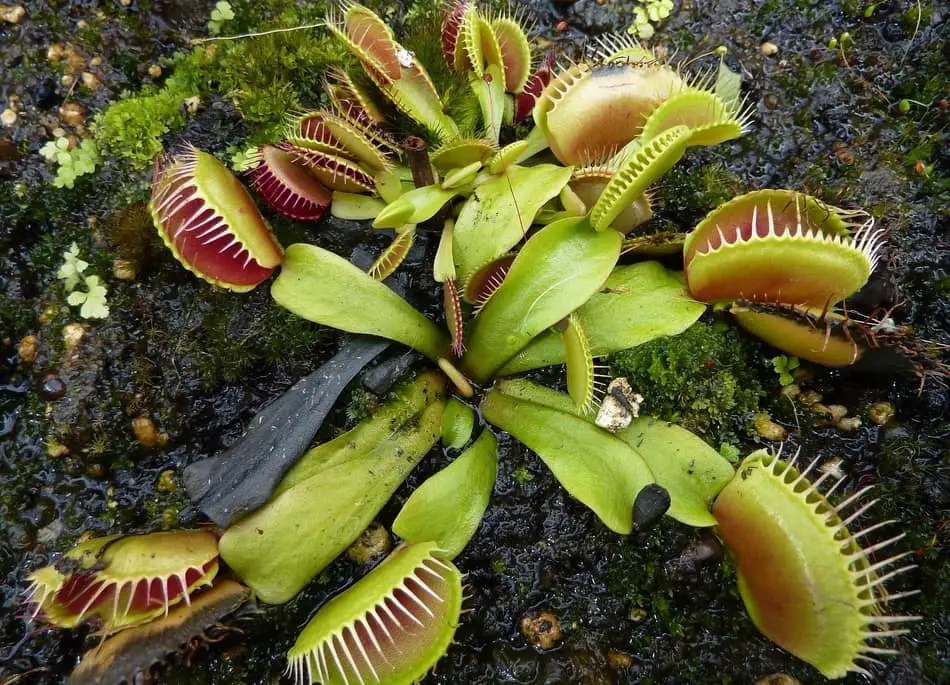
They also require just the right cold temperature or winter dormancy that must mimic the condition of their natural habitat. They require just the right cold condition, most especially during November and February, as it is their dormant period, which happens over winter.
This is also the right time to trim off any dead leaves that turned black during the dormant period as the Venus flytrap will die and then will have a new growth that usually begins in March.
Just like other carnivorous plants, these plants also need water. When they are out in the wild, they can survive with rainwater, but if they are being cultivated in a terrarium, they are not allowed bottled or filtered water, not even tap water, because of the mineral build-up after some time that will eventually harm your Venus Flytrap.
They will also thrive in soil that is not soaked in water, but has the right dampness and wetness. They will also not thrive in soil that is too dry as it will also dry them out.
Venus flytraps are also common houseplants. You can find detailed care instructions in this article: Ultimate Venus Flytrap Care Guide. It is an excellent guide to get started in growing Venus flytraps.
Bug Trapping Mechanism
The Venus Flytrap lures insects, including flies, ants, beetles, spiders, and other small bugs, even tiny frogs. They use their reddish interior and their nectar-secreting glands to attract these insects into thinking they found a flower. Once the insects are inside their trap, and this insect has to trip on any of the sensor hair twice, there is a twenty-second leeway before the snare-like teeth will snap shut, and the insect will be trapped to be digested by the enzymes produced by the plant.
Digestion takes a few days and will depend on the size of the insect. The Venus Flytrap will reopen after a few days and will wait for other insects to become its prey once again.
More Information
We consider the Venus Flytrap a threatened species because of over-harvesting and habitat destruction. There is also overgrowth of bushes and other trees that mostly cover the sunlight that these plants highly require. The botany of this plant is still being studied further.
2. Butterwort (Pinguicula)
Another type of carnivorous plant that can easily lure insects because of the sticky substance found in their leaves.
They may be unnoticeable with a greenish-yellow color. They bloom in spring and will produce purple or pink flowers, also yellow and purple. Known to have around twelve different species.
They are often found in humid regions that are mountainous, such as Central America and South America, we can also find them in Mexico. Butterworts’ habitat includes springs, shore banks, gravels, damp meadows, rock walls, among others.
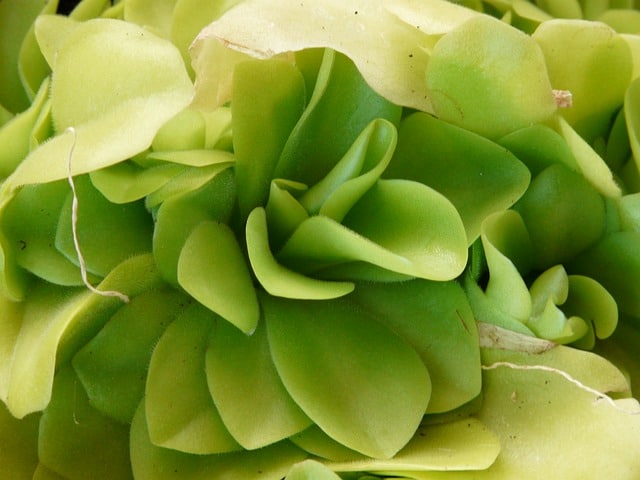
Care Considerations
These plants prefer acidic soil and will need well-drained soil. It will also grow more in just the right sun exposure.
If they are to be brought indoors, they must have just the right sunlight, temperature, and moist soil condition. A humid environment and in winter, they also go into state dormancy, and during this period, they will not need too much water but just the right soil moisture.
They are used to ward off insects when inside the house, as they will feed on them.
Bug Trapping Mechanism
As this plant grows in nutrient-poor soil, they must take their nutrients from their prey for survival.
The leaves of the butterworts lie flat on the ground. It has a smooth and rigid quality to attract insects to crawl on them. It then secretes a sticky mucous substance that makes the luring of the insects easy as the leaves look inviting.
Once the insects start to get attracted and investigate and get close to the leaves, they can no longer escape as the plant will release digestive enzymes from these leaves.
The enzymes help in breaking down the insect and make it digestible for the plants until only the hard skin and indigestible parts are left.
More Information
We consider butterworts threatened or endangered species because of the habitat-related issue these species are facing. The development of land for commercial and industrial purposes, lands where most of these plants thrive on, are used to build structures, thus destroying their habitats.
Humans also remove them from their habitat to sell them for novelty purposes or to have something they can use in their house against insects. Also, humans, sometimes not knowing what they look like when they approach these plants, will just trample on them and their surroundings.
3. California Pitcher Plant (Darlingtonia Californica)
We find these plants in Northern California and Southwestern and coastal Oregon. It usually thrives on fens, stream, pond margins, seeps, and sphagnum bogs.
They can tolerate living in serpentine soil, unlike other plants. We find them mostly on the pond, cliff, or stream edges, plus they can tolerate full sun, but they will thrive most in the partial shade.
Their striking characteristic is their green stalks and bulbous cap plus a wing-shaped leaves that protrude from the top of the bulbous cap. They got their name cobra pitcher plant because of the winged leaves.
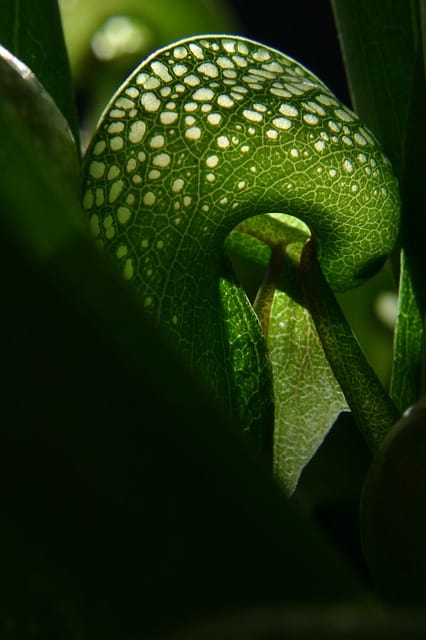
Can easily grow up to three feet, and color can vary between shades of red and brown while the flowers will point down to keep the pollen safe from rainwater.
Care Considerations
The California Pitcher Plant requires icy mountain water, and their roots must be kept cooler than the rest of the plant. If you are cultivating them, you must use cold, purified water as they prefer such temperature.
When it is summer, they would need a cooler location, but they also need just the right amount of humidity.
They also undergo a dormancy period that will last between three to five months. In springtime, they will shoot up pitchers throughout the summer.
Bug Trapping Mechanism
Bugs and insects are drawn to the pitcher’s mouth by the nectar and its color. The slippery quality of the pitcher-shaped leaves disorients the insects and bugs, making it impossible for them to find the exit. They will still try to exhaust themselves into finding where they can leave the plant until they weaken and will slide down towards the bottom of the pitcher to be dissolved by the substance being secreted by the plant.
Since the California Pitcher, Plants are only restricted in moist and bog areas and are being observed by the conservationist, making sure that the species will not be endangered or threatened.
4. Yellow Pitcher Plant (Sarracenia flava)
This plant is also called trumpets and is one of the tallest pitcher plant species.
We mostly find them in the southeastern United States. A notable characteristic is the simple nodding flowers and leaves that look like hollow pitchers, which double as the trap for insects.
Mostly found in nutrient-poor soil conditions and consuming the insects brought forth an advantage to their growth.
They have yellow-green or red-veined pitchers that grow up to three feet tall. Its large yellow five-parted flowers bloom from April to May and accordingly have a stinking smell that it emits that smells like cat’s pee.
This plant is beautiful, and its exotic flowers are wonderful to look at, especially during spring.
Care Considerations
This plant thrives in full sun and needs consistent moisture in the soil. Soil that is dried out will surely mean the demise of this species. Fertilizer is also not needed for it to grow. Some insects can damage this plan, such as mealybugs, aphids, large wasps, moth larva, and tortrix moth.
It can grow from eighteen to thirty-six inches tall.
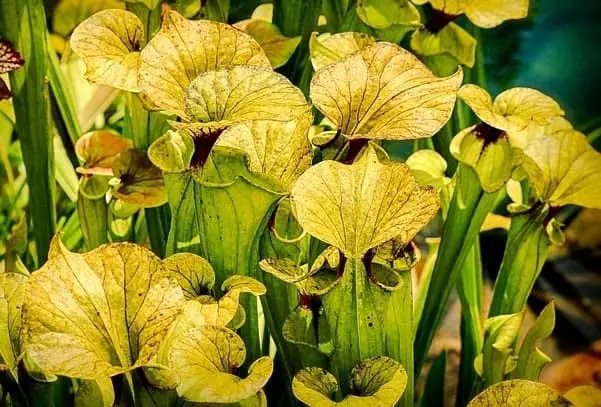
Bug Trapping Mechanism
Just like other species of the yellow pitcher plant, this species also contain sugars to help lure insects in. The sugars have an alkaloid (coniine) component, which weakens the prey, making it impossible for them to escape their predators.
But unlike other carnivorous plants that close to trap its prey inside it, the Yellow Pitcher Plant is more passive because it just lures its prey inside with its nectar, which the insects cannot forego, and they became victim once they slide downwards inside the pitcher to be digested by the plant’s enzymes.
Conservation
Yellow Pitcher Plants helps in limiting the insect population and is an advantage for biodiversity.
However, their habitats are being destroyed because of deforestation and urbanization. Humans are also selling these plants for profit.
This plant is currently not on the threatened or endangered plant species. They are protected and placed in parks and conservation areas.
Conservation efforts are in place, such as protecting their habitats, prescribed burning to remove bushes, and other higher canopies to give way to sunlight.
5. Drosera Capensis
Commonly known as Cape Sundew and mostly found in marshes, seeps, streams, or any damp areas. This plant is native to the Cape of South Africa, but it is now becoming an invasive species like in New Zealand as the plant spreads on their own and mostly with the help of the birds.
We also find them in Australia, California, and South America.
Propagation and Care
They can easily propagate as well and even if brought indoors because it does not get easily affected by the change in temperature unless it is in a long duration. It also does not undergo dormancy, grows well in the open air, or on your window.
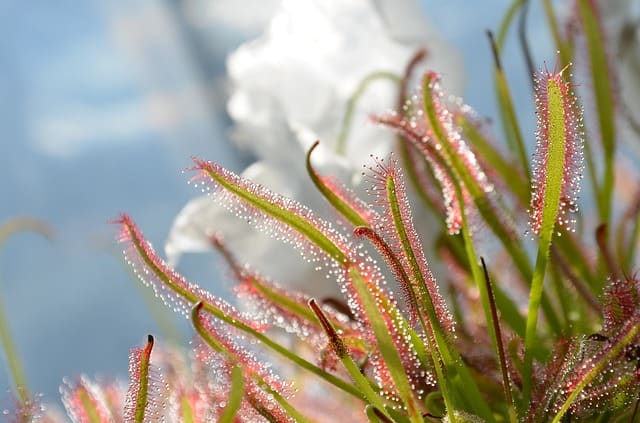
Its propagation includes seed, leaf, and root cuttings. Soil with water is also good for its survival. It can also withstand full sun exposure and a less sunny atmosphere.
The seed of this carnivorous plant can find its way in the neighboring area since they germinate and sprout easily and the reason it has a reputation of being a weed.
Although they are coined as carnivorous, it also has its enemy, such as aphids, thrips, and mealybug.
Bug Trapping Mechanism
This plant has strap-like leaves that root towards the center once an insect gets trapped in it. The plant leaf surrounds the prey, and with the help of other tentacles, the prey gets trapped further.
Cape Sundew captures their prey with the use of dazzling digestive secretions that are found on the leave’s tentacles. This in turn will act as a visual signal as it shines under the sun and further attracts the insects to get near it.
Once an insect gets caught in the secretion of the tentacles, other tentacles will further help using every strand to wrap and imprison the insect.
The digestive secretion will do its task of digesting the cretin until only hard components of the insect remain.
After everything settles, the leaf and the tentacles return to its original position.
This plant secretes mucin to trap their prey, and it has a high viscosity and contains a high composition of acidic polysaccharide.
Interesting Facts
Although some species of the sundew can self pollinate and other species can reproduce with the seeds, there are still species of sundew that are listed as endangered in some states. The reason is the loss of their habitat.
Drosera has its medicinal use, and the extracts of the leaves were used to remove corns and warts while there is some medicinal help with asthma, coughs, stomachache, toothache, liver pain, among others.
6. Nephentes Alata
This plant is common in the Philippines and is considered highly polymorphic and shows a wide variety of traits such as the pitcher shape and its color. The color ranges from yellow-green to red, to orange, purple, to speckled, and more.
The pitcher shape also varies in size and shape, some are slender while others are wide mouth or cylindrical in the upper half while it is rounded at the bottom.
The characteristic of serrated wings along the ant trail is also prominent.
Just like other carnivorous plants, it uses its nectar to attract insects to its pitcher. There is a pitfall trap that makes it impossible for the insects trapped inside to find an exit.
Adaptations
These plants have adapted over the years. They have evolved with the use of insects as their food even if there is a limited resource, their existence continues.
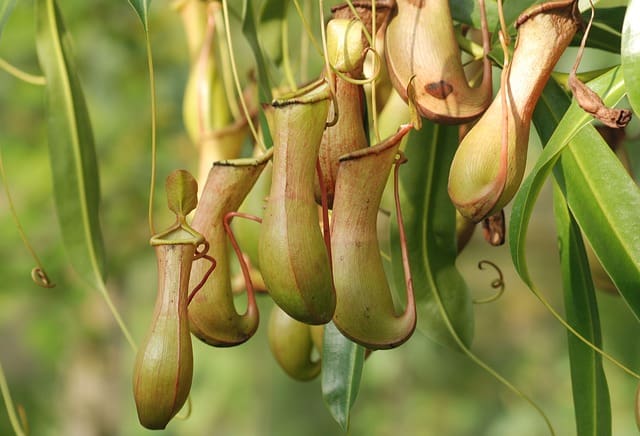
The Nephentes Alata is considered a lowland plant but can also tolerate the highland conditions and is not too hard to propagate in soil or on trees.
It is a survivor as it attaches itself to a narrow stem as it grows tall until it is all that is found hanging on bushes or branches of trees. They grow quickly, and they can adapt to their surroundings.
There are some organisms that this plant competes with, such as spiders, because it can build webs on top of the plant making it get its fill first instead of the plant.
Some primates can steal insects from the traps as well and rob them of their food.
The growth of this species is easy, and it is not considered endangered or threatened except for some species of Nepenthes that are critical while some are considered vulnerable.
Bug Trapping Mechanism
As the insects think the pitcher is a safe place to find food, it will enter the plant until it is too late, and it is trapped inside. The nectar glands are surrounding the pitcher, thus attracting the insect inside and will find the sweet fluid.
They will also find out that they cannot exit the plant because of the slippery inner surface, which will then make them fall off and slides further inside the pitcher traps. Further, inside the pitcher traps, there are digestive enzymes pooling at the bottom, which will drown the insect and digest it so they can use it for its nutrients.
7. Drosera Aliciae (Alice sundew)
Another carnivorous plant in the Droseraceae family that can be found at the Cape Provinces of South Africa and is one of the most common sundews in breeding.
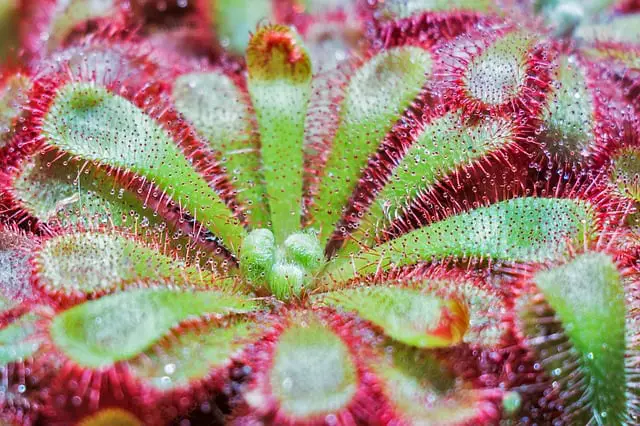
Its distinctive character is its fairly thin, long roots, spoon-shaped leaves sized at 25mm long and with 7 mm width. Leaves are also similar in size and have a reddish color, plus reddish, glandular, and sticky hair covers it.
Its flowers can grow quite large, and the plant can get tall plus the leaves can get long and bigger up to three inches.
Mostly found in marshes, streams, damp area, and permanent seeps.
This plant flourishes by snacking on insects and trapping them inside.
Care Considerations
This plant can self pollinate or pollinated with the help of insects.
The Drosera aliciae is not an overly sensitive plant, as it can grow well in any temperature and requires little to propagate. It can tolerate drier or moist soil, and it can handle warmer temperature, but humidity below forty degrees may not be helpful for this plant.
When exposed to full sunlight, color may turn red-orange, and for less sunlight, it will turn orange-green leaves and will have red tentacles.
Also, it does not need dormancy, unlike other carnivorous plants.
If brought indoors, it is best for terrariums and windowsills with temperatures between forty to ninety degrees. Use rainwater or distilled water and not water with high mineral content.
Bug Trapping Mechanism
The plant hairs exude a sticky substance that attracts and lures insects and other small prey that is present.
The secreted enzyme has a sweet scent to attract insects. Once the prey got lured, the tentacles will know when there is a prey caught up and will then continue to engulf the insect by the sticky glands, also known as tentacles and digested enzymes.
The nitrogen that this plant gets from the digested insects completes its requirement for it.
Medical Properties
The Alice Sundew was known to help in various ailments as well, such as eye and ear infection, morning sickness, stomach issues, syphilis, toothache, so forth, and so on.
Good thing that this species is not threatened nor endangered.
8. Round-leaved Sundew (Drosera rotundifolia)
This plant is one of the most widespread among the sundew species. Found in northern Europe as well as in Syberia, Korea, Japan, and in large parts of Northern America. They are also widespread in New Guinea, California, Mississippi, and Alabama, USA.
This species grows from three to five centimeters.
Found mostly in wet meadows, or in nutrient-poor sites, which include heathland, moorland, freshwater, fens, bogs, and areas with low to middle elevation.
It has a similarity to the great sundew, just have a difference in the shape of its leaf.
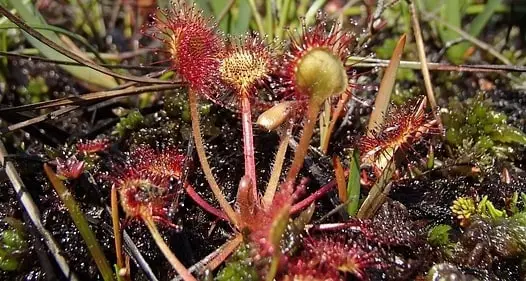
Due to a lack of nitrogen in their environment, this plant must compensate by eating insects and getting minerals and nutrients from the insect that they usually consume.
They usually prey for a creature or two a month, and their victims include mosquitoes, smaller insects, and may sometimes include the hapless butterflies and mosquitoes if there is no other option around.
Successful hunters that can trap insects as often will grow larger and will have an abundant bloom of flowers.
It prefers open, partly sunny, or even direct sunlight.
This species can be identified by its greeny-red leaves that are covered in red hair and arranged at the base of the plant, making it appear like a rosette. It also has a rounded shape leaves.
Bug Trapping Mechanism
On its hairlike tendrils, there are glistening droplets that attract passing insects. The sticky substance is sticky, and once the insect sticks to it, they are trapped because once the tendril detects their presence it will curl inwards to further trap the insect. The insect will try hard to set itself free, but it only pushes itself inward until the whole leaf wraps around the prey.
The insect inside the plants will get digested with the digestive enzyme that the plant emits. Once the digestion is done, this plant will absorb all the nutrients taken from the insect.
Multiple Uses
There is information that the dew of this plant was once used as an anti-aging potion, which was believed in the olden days.
The sap is also used to curdle milk, while in Europe the leaves were used to make cheese and milk dessert, not to mention the antibiotic effect that this plant supposedly has.
Conservationists didn’t find this plan endangered or threatened, but common.
9. Waterwheel Plant (Aldrovanda Vesiculosa)
The waterwheel plant is similar to other carnivorous plants called Venus Flytrap, but this plant victimizes small aquatic invertebrates using their traps. This plant is capable of rapid movement.
This plant is a rootless aquatic plant with floating stems. The traps have petioles that hold air sacs, which makes it possible to float.
Found in clean, shallow, standing water with bright light, warm and with a slight acidity or pH.
This plant just floats just beneath the water surface together with other aquatic plants. The only thing sticking out is its flower, which is a single white flower on top of the branches. A flower that only opens for a few hours and closed after to go back underwater.
Survival
The waterwheel plant survives on small prey, and using their snap trap underwater, they can survive for a long, and their existence even dates back fifty million years ago.
The Water Wheel requires a lot of sunlight and sometimes may fight with algae that crowd them for survival.
During winter, as a frost survival strategy, the Aldrovanda will produce turions that break off the mother plant and sinks to the bottom of the water as the temperature under are more stable and the chance of survival is high.
When spring arrives, the turions will float to the top of the water, where they will germinate and continue the growth process.
Bug Trapping Mechanism
The trap of Aldrovanda comprises two lobes that fold together once there is an insect in its lair. It snaps just like a Venus Flytrap to keep the prey inside.
The closing of the trap takes ten to twenty milliseconds, which is faster according to standard The fast trapping is possible during warm conditions of twenty degrees Celsius at least.
It prefers tiny insects and small fishes or tadpoles.
Conservation Efforts
The waterwheel plant is considered sensitive and has undergone a huge decline as their habitats got destroyed by humans.
They previously have over four hundred populations, but have gone down to a measly fifty.
Conservationists are working hard to monitor the waterwheel plants and their habitats. They are being reintroduced in areas where they have been extinct.
The hope that these plants will be able to survive endangerment is high.
10. Aquatic Bladderworts (Utricularia Vulgaris)
Bladderworts have over two hundred species and can be found in freshwater and wet soil as aquatic species and also cultivated for its flowers because of its orchid-like quality.
Aquatic bladderworts are another carnivorous plant that mostly captures small organisms in its traps.
We find them in South America and also in Australia.
Twenty percent of the species are aquatic, where they are found freely on top of muddy waters and get to the surface when they are flowering. Some even live on rapidly moving streams and waterfalls.
This type of bladderworts prefers growing in acidic waters, but because of high competition, they have adapted to live in alkaline waters.
Environment
These plants prefer warm or partially sunny environments. They easily grew as long as there are no algae around to compete with.
Aquatic bladderworts prefer acidic pH, plus a nice combination of CO2 in the water as they will grow abundantly with the right combination of gas plus the availability of food.
Dormancy is required for the Aquatic bladderworts as they develop turions over the winter and will sink at the bottom to reemerge at the right time and temperature.
They mostly survive on insect larvae, mosquito wigglers, daphnia, water fleas, invertebrates, and protozoa.
Bug Trapping Mechanism
Once the hair-like bristles get triggered bypassing animal that will soon become prey, the bladder walls of this plant will spring into readiness, while the door that flies open will suck in water and the insect will be drawn in, and then the door will close making it impossible for the trapped insect to get out.
Once the prey is inside, the enzymes being secreted by the Aquatic Bladderworts will digest it. Digestion may occur for a few hours, while others take days.
Medicinal Use and Conservation
The species of bladderworts are being used to make medicinal tea, while it is also used to treat urinary tract infection, spasms, and swelling. The use of this plant species is still continuously being developed.
There are some states where these plant’s habitats are being cleared for sand mining or areas are being used for the construction of buildings and structures.
As these carnivorous plants require a specific environment to thrive in, there is a danger of them getting threatened, and they must adapt to the fast-changing environment so they can continuously exist.
But as long as they are being introduced intentionally in a different location so they can survive to cultivate, there is hope for this species.

